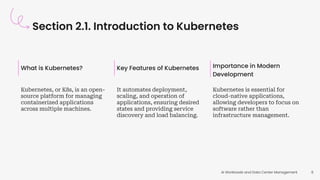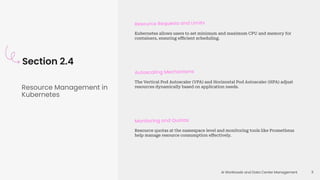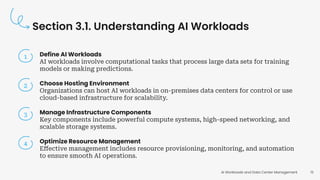Artificial Intelligence Workloads and Data Center Management
- 1. AI Workloads and Data Center Management Presented by Sandeep K S 06.12.2025
- 2. 01 Introduction to Data Centers 02 Kubernetes and Container Orchestration 03 Managing AI Workloads Outline
- 3. Introduction to Data Centers 01
- 4. AI Workloads and Data Center Management 4 Section 1.1 Overview of Data Centers What are Data Centers? Data centers are facilities that house computer systems and related components, essential for digital operations. Key Components of Data Centers They include compute systems, networking infrastructure, and scalable storage solutions for efficient data management. Future Trends in Data Centers Emerging trends like AI, edge computing, and modular designs are transforming data center operations.
- 5. Section 1.2. High-Density Rack Design AI Workloads and Data Center Management 5 1 Understanding High-Density Racks High-density racks are designed to fit many servers in a small space, maximizing computing power. 2 Addressing Heat Management Managing heat output is crucial, as AI servers produce significant heat that can affect performance. 3 Implementing Cooling Solutions Innovative cooling methods like liquid cooling and aisle containment help maintain optimal temperatures. 4 Adopting Sustainable Practices Using energy-efficient hardware and renewable energy sources reduces environmental impact.
- 6. Section 1.3. Energy Efficiency and Sustainability AI Workloads and Data Center Management • Growing demand for computing power drives energy efficiency in data centers. • High energy consumption in data centers necessitates effective power and cooling management. • Innovative cooling solutions like liquid cooling improve energy efficiency. • Companies are adopting renewable energy and smart power management practices. • Metrics like Power Usage Effectiveness (PUE) help measure energy efficiency. 6
- 8. Section 2.1. Introduction to Kubernetes AI Workloads and Data Center Management 8 What is Kubernetes? Kubernetes, or K8s, is an open- source platform for managing containerized applications across multiple machines. Key Features of Kubernetes It automates deployment, scaling, and operation of applications, ensuring desired states and providing service discovery and load balancing. Importance in Modern Development Kubernetes is essential for cloud-native applications, allowing developers to focus on software rather than infrastructure management.
- 9. Section 2.2. Deployment Automation with Kubernetes AI Workloads and Data Center Management 9 1 Define Desired State Specify the desired state of applications using YAML or JSON configuration files. 2 Automate Deployment Kubernetes automatically deploys and scales applications to maintain the defined desired state. 3 Implement Deployment Strategies Utilize strategies like rolling updates for seamless application updates without downtime. 4 Integrate CI/CD Pipelines Combine Kubernetes with CI/CD tools to automate the entire application lifecycle.
- 10. Section 2.3. Scaling and Self-Healing Features AI Workloads and Data Center Management • Kubernetes provides automatic scaling with Horizontal Pod Autoscaler (HPA). • Vertical Pod Autoscaler (VPA) optimizes resource allocation for containers. • Self-healing capabilities restart failed containers and replace unresponsive pods. • Health checks monitor application state and enable corrective actions. • These features enhance reliability and improve resource utilization. 10
- 11. AI Workloads and Data Center Management 11 Section 2.4 Resource Management in Kubernetes Resource Requests and Limits Kubernetes allows users to set minimum and maximum CPU and memory for containers, ensuring efficient scheduling. Autoscaling Mechanisms The Vertical Pod Autoscaler (VPA) and Horizontal Pod Autoscaler (HPA) adjust resources dynamically based on application needs. Monitoring and Quotas Resource quotas at the namespace level and monitoring tools like Prometheus help manage resource consumption effectively.
- 13. Section 3.1. Understanding AI Workloads AI Workloads and Data Center Management 13 1 Define AI Workloads AI workloads involve computational tasks that process large data sets for training models or making predictions. 2 Choose Hosting Environment Organizations can host AI workloads in on-premises data centers for control or use cloud-based infrastructure for scalability. 3 Manage Infrastructure Components Key components include powerful compute systems, high-speed networking, and scalable storage systems. 4 Optimize Resource Management Effective management includes resource provisioning, monitoring, and automation to ensure smooth AI operations.
- 14. Section 3.2. Utilizing GPUs for AI AI Workloads and Data Center Management • GPUs are specialized processors ideal for parallel processing in AI tasks. • They significantly speed up model training and inference compared to CPUs. • Deep learning frameworks like TensorFlow and PyTorch optimize GPU usage. • Cloud computing provides flexible access to GPU resources for AI. • Challenges include cost and complexity in GPU implementation. 14
- 15. Section 3.3. Job Scheduling Techniques AI Workloads and Data Center Management 15 Overview of Job Scheduling Job scheduling is the process of managing tasks in computing environments to optimize resource use and minimize wait times. Common Scheduling Techniques Techniques like FCFS, SJN, Priority Scheduling, and Round Robin each have unique advantages and applications. Importance in Computing Effective job scheduling is crucial in high-performance and cloud computing to ensure efficient resource management.
- 16. Section 3.4. On-Premises vs. Cloud Solutions AI Workloads and Data Center Management 16 1 Evaluate Control Needs Determine the level of control required over data and infrastructure. 2 Assess Financial Investment Consider the capital investment needed for on-premises solutions versus the pay- as-you-go model of cloud services. 3 Analyze Scalability Options Examine how quickly and easily resources can be scaled in both environments. 4 Consider Long-Term Strategy Reflect on the organization's future needs and potential challenges with data management.
- 17. Section 3.5. AI Infrastructure Management AI Workloads and Data Center Management • Resource provisioning is essential for AI workloads. • Continuous monitoring ensures optimal performance. • Automation tools streamline deployment and management. • Robust security measures protect AI infrastructure. • Energy efficiency is crucial for sustainability. 17
- 18. Take Home Messages AI Workloads and Data Center Management 18 THE ROLE AND EVOLUTION OF DATA CENTERS Data centers are critical facilities that support digital operations by housing essential computing and networking components. They are evolving with trends like AI and edge computing, which are reshaping their design and functionality. KUBERNETES: THE BACKBONE OF MODERN APPLICATION MANAGEMENT Kubernetes is an open-source platform that automates the deployment and management of containerized applications. Its features, such as scaling and self-healing, are essential for efficient resource management in cloud- native environments. OPTIMIZING AI WORKLOADS FOR PERFORMANCE AND SUSTAINABILITY Managing AI workloads involves understanding their unique requirements, utilizing GPUs for enhanced processing, and implementing effective job scheduling techniques. Balancing control, scalability, and sustainability is key to successful AI infrastructure management.
- 19. Thank you for your attention!


















